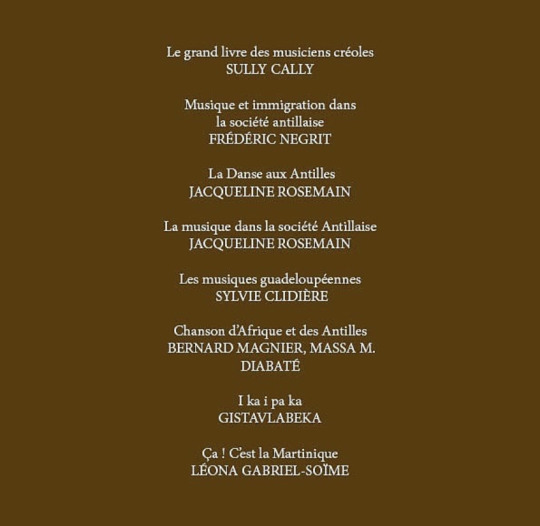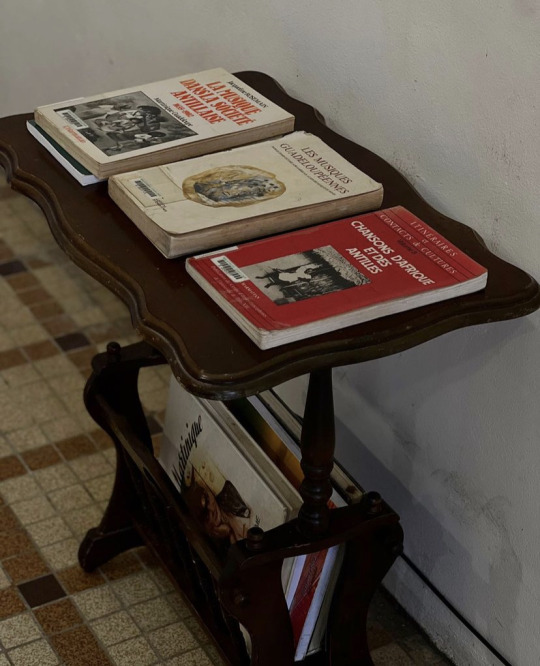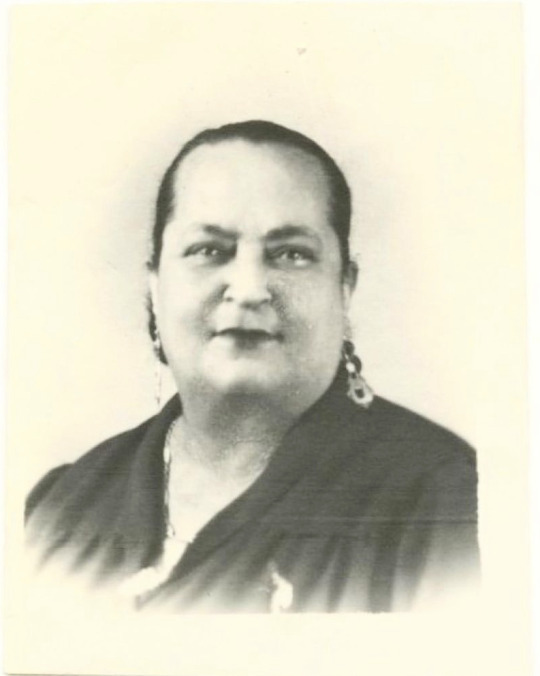Text



Curated by Jade Bassien - Capsa for the first momentum of our program, this books curation was conceived to provide an introduction to the diverse genres of Caribbean music, with a particular focus on Martinique and Guadeloupe. We have carefully selected texts that illuminate the intricate connections between music and the histories of these islands, marked by themes of struggle, opposition, resilience, and creativity. Through the genres of Biguine, Gwo Ka, Bèlè , and Zouk music, our aim was to shed light on the contributions of musicians who have not only shaped but also significantly influenced music well beyond the confines of the Caribbean.
The various music genres found in the Caribbean mirror the diverse cultural identities of each island. This musical history is intricately intertwined with political strife, acts of resistance, and the flourishing of artistic and cultural expression. It is the result of a dynamic fusion, born from the fusion of traditional African rhythms, European influences, and Latin elements, resulting in something entirely novel and groundbreaking. This fusion is why Caribbean music stands as the true essence of Creole / Caribbean Culture.
Jade Bassien-Capsa ( @jadesrooom ) is a Guadeloupean writer and cultural researcher based between Paris and London. She graduated from l’École Normale Supérieure Paris in Art History and History, working primarily on youth culture and counter-cultures, specifically on teenage girls. Now, she is focusing on the effects of intergenerational trauma on the minds and bodies of the afro-caribbean people. Apart from research papers, her means of transmission are poetry, zine making and collages. In her works, she emphasizes the importance of both personal and national archives. Jade is as well the co-creator of the program SIANO .
0 notes
Text




SIANO Micro - Space at Seize Mètre Carrés, Fort - de - France in Martinique | 26.08.2023 - 03.09.2023
Being part of the first momentum of our program, this micro space aimed to nurture the audience with archives such as photographies and materials ; A selection of texts and essays curated by Jade Bassien-Capsa ; Two mind maps imagined and created by Artist and Parolière Simone Lagrand entitled “ 24 hours in the life of a young Martinican woman “ , these mind maps take the form of a narrative exploring a multitude of thoughts and references on caribbean sonorities incorporated in the life of a main persona named “ Beverli “ .
And finally , a sound installation - with selected caribbean songs - that could be experienced in communion.
Courtesy by Sarah Louis-Michel
0 notes
Text

Kassav is an emblematic group in Caribbean music, its story begins with Pierre-Edouard Decimus, a member of Les VIKINGS, and Freddy Marshall, who conceive an innovative approach. Teaming up with Georges Decimus and Jacob Desvarieux, the group blends traditional Gwoka rhythms with modern techniques to create a new sound. Kassav emerges as an experimental concept, driven by reflection and a desire for progression. The first album, "Love and Ka Dance," is released in 1979.
Kassav evolves through various formations, exploring names like "Soukwé kò'w" or Kassav. The group stands out by predominantly performing live, recording numerous albums collectively and over thirty solo albums by its members . KASSAV was as well composed of Jocelyne Béroard , Jean Pierre Bélony, Patrick Saint Eloi, Jean Claude Naimro and Claude Villa .
Kassav became a symbol of pride and recognition for Caribbean music, captivating an expanding audience in Guadeloupe, Martinique, France and worldwide and where it embodies an identifying culture for youth distant from their island origins.
The initial albums, deemed "ethnic" by major labels, are produced by Caribbean record companies and distributed by Sonodisc. From 1984 to 1987, Kassav partners with GD Productions, gaining international recognition with the 1984 album "Zouk-la sé sel médikaman nou ni," there by popularizing the term "Zouk" for their musical style.
Since 1985, Kassav has toured the world, drawing massive crowds in Africa, the Caribbean, France, and beyond. Hits like "Kolé séré" and "Zouk-la sé sel médikaman nou ni" enjoy great success.
Despite distribution challenges, their impact endures, even inspiring new dances and musical styles. The story of Kassav, which commenced three decades ago in the Caribbean islands, showcases a unique creative fusion and a lasting musical influence on a global scale.
Photography of KASSAV festival de cannes in 1984 - Photographer unknown
4 notes
·
View notes
Text

The Biguine originated, end of the 19th century in Saint-Pierre, the former capital of Martinique, before the tragedy of 1902 . Musicians combined it with traditional bèlè and the Polka . The predominant instrument of the Biguine was the clarinette .The syncopated nature of this music contributed to the success of the biguine .
However , we must question the political and societal aspects of Biguine during this era and its role in the cleavage in the Martinican community . In fact, the biguine was associated to a certain type of Martinican people : Mulâtre and Mixed ( white / black ) people mostly
Practicing biguine was an indicator of elevation in the « new society » . Some people wanted to claim a new social belonging and to do not be seen or/and associated to the negro of the Mornes . This, created a classicism already very present in the Martinican society since the enslavement period .
Léona Gabriel - Soïme or Miss Estrella , was a biguine pioneer, born in 1891 in Rivière-Pilote, Martinique and coming from a rich family, she was surrounded by the songs of the plantation workers on her father's estate, a "white Creole “ or “ Blan Kréol “
[ Blan Kréol : In the 19th century , a Blan Kréol is a direct descendant of colonizer named « Béké » in Martinique and Guadeloupe or a white person installed in Martinique who owned a business or/and a plantation ]
She captivated the Martinican audience with her voice, singing about Martinique .
Léona also composed biguines and mazurkas, which became great classics of the traditional Martinican repertoire: such as "a si paré," and "maladie d'amour," a song later covered by her nephew Henri Salvador. When she moved to Paris around 1920 she became closer to Caribbean musicians , becoming the lead singer for Stellio's orchestra, with whom she toured France .
In 1948, Léona returned to Martinique and gave numerous recitals in Martinique and Guadeloupe and hosted "Ça c'est la Martinique" alongside prominent musicians such as the trombonist Archange St-Hilaire and Hurard Coppet
Photo of Leona Gabriel, 1952
Partition of “ Ah ! Mi Roro “
0 notes
Text

We are humbled, joyful and proud to introduce : Siano
Siano is an impulsive, tangible and multidisciplinary educational program that explores Caribbean sonorities in Martinique and Guadeloupe from 1930 to 2000 ; and more specifically : Bèlè, Gwoka, Biguine and Zouk .
This program is elaborated with historical contexts, cultural awareness, and necessary knowledge elements through four momentums out of five months in order to bring a deeper understanding and appreciation of these Caribbean sonorities and its pioneers.
Siano also strives to demonstrate that these Caribbean sonorities are solid and meaningful responses to the cultural genocide that occurred during the colonial era in the caribbean .
In present society, these sonorities are entirely part of the Caribbean identity and convey a profound spirit of Marronage [ Mawonaj ]
Siano takes its name from Eugène Mona's notable song “ Siano “ from his album “ Blan Manjé “ published in 1990 .
Graphic Designer : Marthe Khady Nachtman
0 notes
Text
https://www.instagram.com/nianiba/?img_index=1
1 note
·
View note